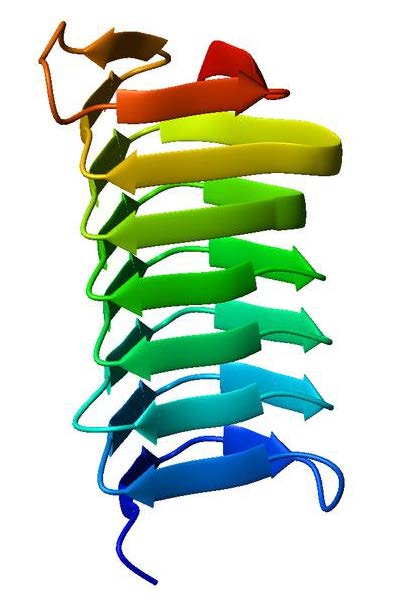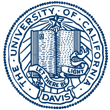
This REU program was funded through NSF PHY-1004848.
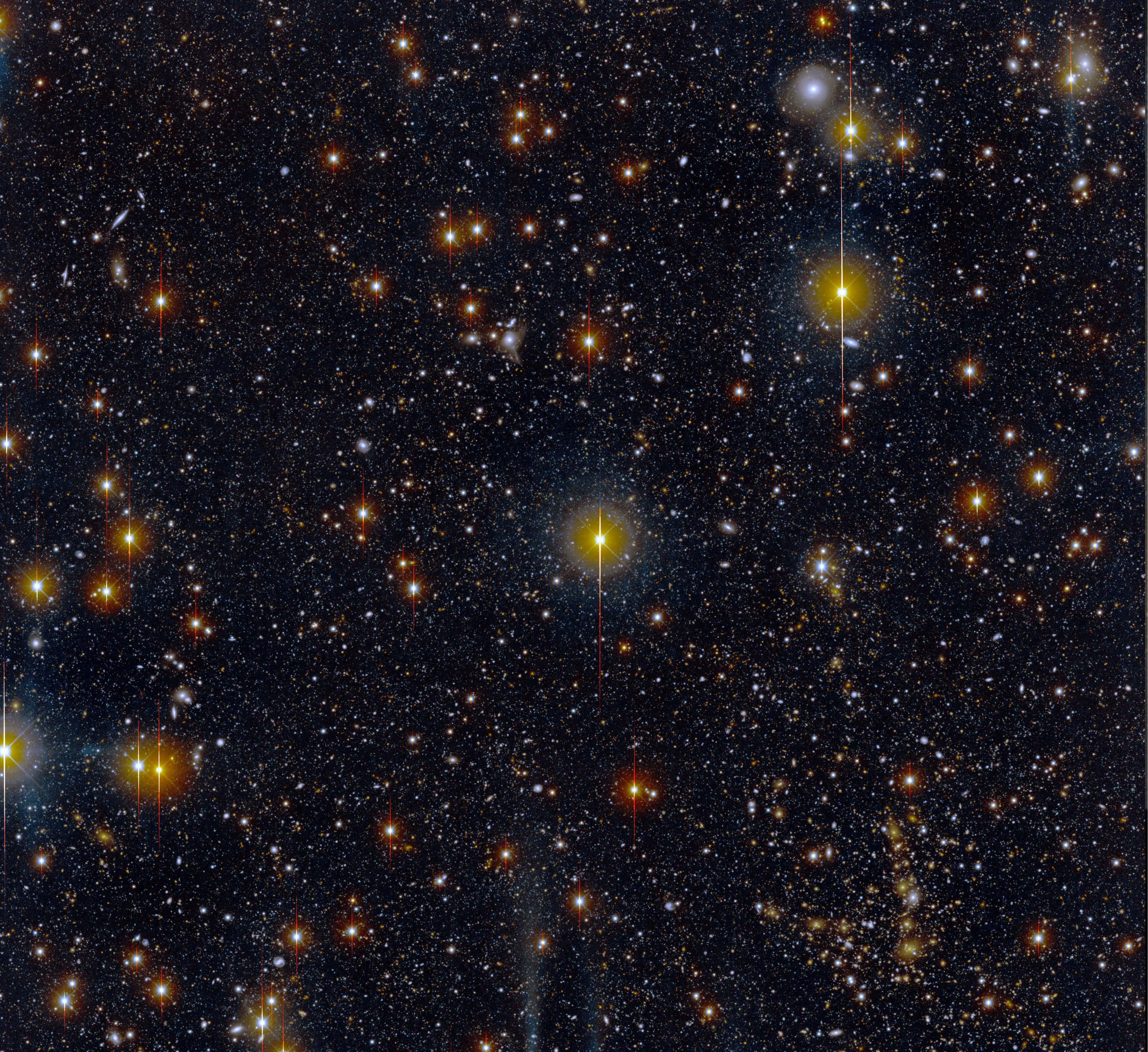
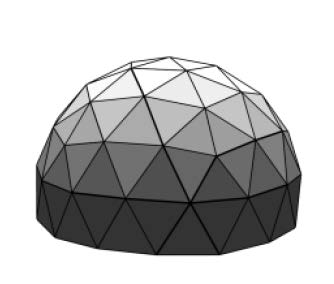
These images are related to our REU projects. The first one is a Deep Space Survey image. These are the kinds of images used in the observational cosmology project. The second one is an illustration of discretizing a curved space time. One needs to build space out of discrete blocks in research involving quantum gravity.
Students' names link to their final papers. Advisors' names link to the research group web pages.
Condensed Matter, Theory and Experiment
The behavior of materials at interfaces is particularly important in fabricating new types of microscopic devices. Dylan Lovinger (University of Massachusetts Amherst; advisor Shirley Chiang) used Scanning Tunneling Microscopy (STM) to image iridium atoms on the surface of germanium. STM is a static measurement that achieves atomic or near-atomic resolution. At temperatures of about 680 K, the STM images show that the Iridium atoms form islands and that there are small pathways connecting these islands that are only a few atoms wide. Dylan focused on studying how these pathways emerge, and how they are formed at various temperatures.
Disordered superconductors have been an interesting subject of study for many decades. Some types are expected to have thermodynamic properties that are unaffected by the degree of disorder (Anderson’s Theorem). Spin-independent disorder has been the subject of recent study, but a new optical lattice technology allowed Tyler Cary (Rensselaer Polytechnic Institute; advisor Richard Scalettar) to study spin-dependent disorder in two-dimensions. He found that the order parameter of the superconducting transition was very sensitive to the degree of disorder.
A summer project involved the study of the magneto-optical properties of quantum topological insulators.These materials are insulators in their bulk, but can conduct in their surface. Their surface properties can change when a magnetic field is applied, and these can be seen by shining light on them, and observing changes in polarization. Amber Schedlbauer (New Mexico Tech; advisor Xiangdong Zhu) was able to test techniques for observing this effect, and was able to determine that a magneto-optical response was produced in the material, showing that the technique used was effective for studying these materials. An image from Amber's work can be seen below.
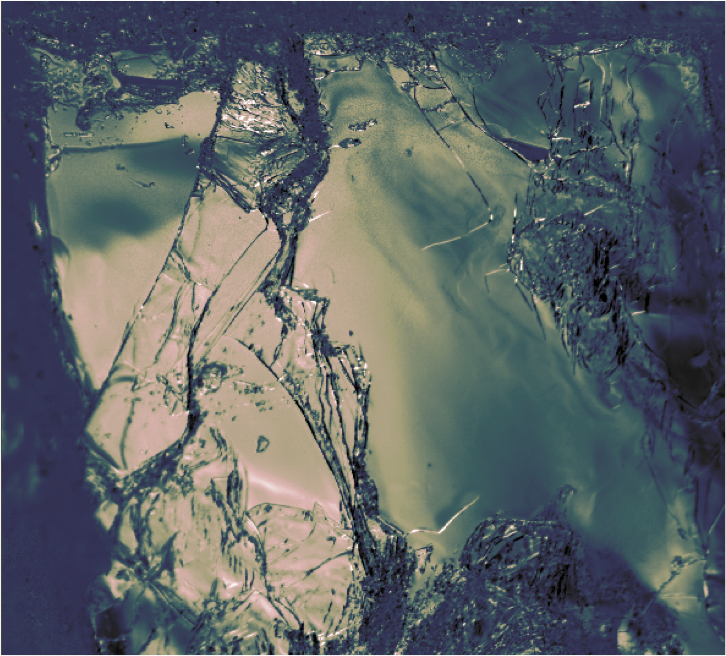
On the same topic of topological insulators, Maxwell Klefstad (Cornell University; advisor Dong Yu) worked on nanowires made of these novel materials. When on works with topological insulators, surface conductance measurements are often obscured by impurities in the bulk. Nanowires made of a topologically insulating material provide a solution to this problem with their large surface-area-to-volume ratio. Max examined the growth procedure for topological insulator nanowires.
Biological Physics
Knowing a protein's three-dimensional structure is crucial to understanding its behavior. Alanna Weisberg (Harvey Mudd College; advisor Daniel Cox) worked on a studying the structure of a protein called p53, which is a tumor-suppressor found in humans. When this protein detects the presence of an error in the DNA of a particular cell, it will induce apoptosis. It is therefore very important to keet this protein functioning properly, but mutations in p53 can cause problems. Malfunctions in p53 are implicated in over half of all cancers, so it is important to understand how it misfolds. Alanna spent her summer using a threading program and molecular dynamics simulations to test some strucures that these proteins might adopt when they malfunction, including a "Left-handed-beta-helical" structure, shown in the picture.
General Relativity
Causal Dynamical Triangulation (CDT) is an approach to quantizing the theory of gravity. The idea is to divide ("triangulate") spacetime into fundamental shapes and then study the spacetime as it undergoes a random walk among possible triangulations. Christian Anderson (Harvard University; advisor Steve Carlip) studied a version of gravity that is more amenable to treat using path-integrals, similar to the techniques used in high energy physics. The path integrals calculate the action over many (in principle all) possible paths. The action Christian used is one introduced by Horava and Lifshitz to make gravity amenable to the path integral treatment. This new action for gravity introduces high energy terms, but it was not known if the effects of these terms were restricted to high-energy only, or if these effects would stay when the CDT space times were looked at different scales, so Christian worked on answering this question, and prepared a paper together with the quantum gravity group at UC Davis.
Nuclear and Particle Physics, Experiment and Theory
The Solenoidal Tracker at RHIC (STAR) is an experiment which looks at collisions of very large nuclei such as gold (Au). It does so at ultra-relativistic energies. At these energies, the temperature generated in the core of the collision is hot enough that the protons and neutrons which form the nuclei undergo a transition to a new phase of matter. In effect, the nucleus melts. The hot phase of nuclear matter is called the Quark-Gluon Plasma, in reference to the quarks and gluons which are the particles that make up the protons and neutrons. Cameron Mattie (University of Kentucky; advisors Manuel Calderon de la Barca Sanchez and Daniel Cebra) studied collision data from the STAR experiment, and worked on identifying the particles that come out of the collision. The momentum distributions of the particles of the collision can tell us the temperature, i.e. how hot it was, at the last stage of the evolution of the hot fireball. These temperatures are hundreds of thousands of times hotter than the sun's core. An event display from the STAR detector is shown below.
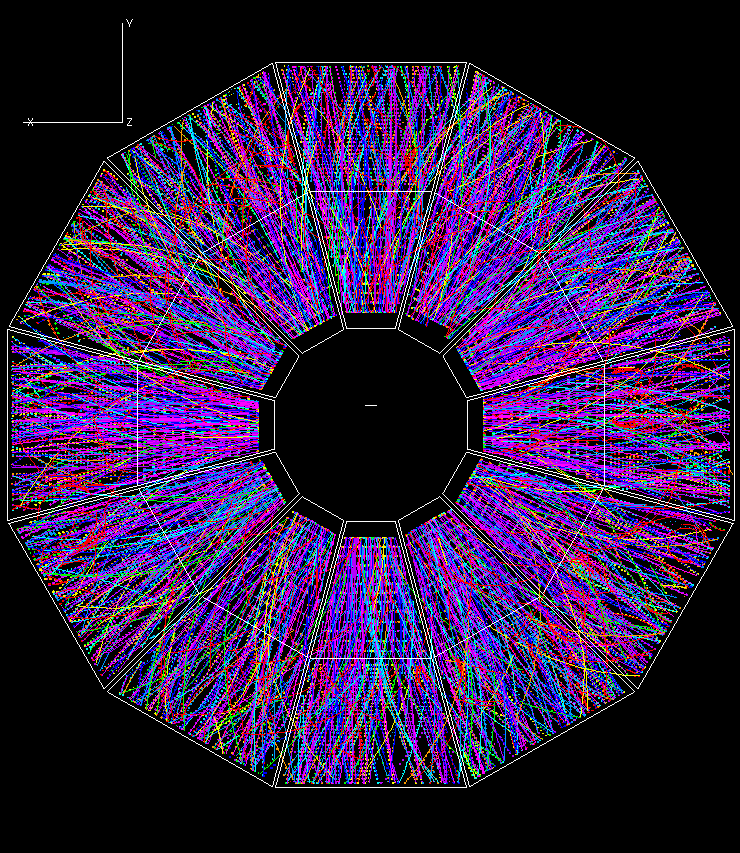
The Long Baseline Neutrino Experiment (LBNE) is an experiment which will use netrinos generated at Fermilab which will then propagate through the earth's mantle until they reach a water detector hundreds of kilometers away. These experiments can teach us about neutrino oscillations and Charge-Parity violation. Jonathan Aronson (Brown University; advisor Bob Svoboda) used code that Generates Events for Neutrino Interaction Experiments (GENIE) to simulate neutrino and antineutrino events in the volume of the 700 kTon water detector. He simulated charged current and neutral current interactions, and scanned through the simulated events to check the software which reconstructs the ring patterns observed in the detector. These rings are the result of Cherenkov radiation produced by electrons which travel faster than light inside the water of the detector (no particle can travel faster than light in a vacuum, but in a medium, a particle can travel faster than light in that medium, and will produce this tell-tale Cherenkov radiation signature).
The International Linear Collider (ILC) is a proposed particle collider to complement the LHC, reaching energies of 500 GeV in the rst phase and 1000 GeV in the second phase. Major goals of the ILC include understanding the mechanism behind mass generation and electroweak symmetry breaking, searching for and perhaps discovering supersymmetric particles and con rming their supersymmetric nature, and hunting for signs of extra space-time dimensions and quantum gravity. The detectors of the ILC will record and measure the charged and neutral particles produced in the ILC's high energy e+e- collisions and must achieve unprecedented precision to reach the performance required. Alexandra Moskaleva (California State University, Sacramento; advisor Mani Tripathi) worked on investigate the characteristics of gold studs when used for bump bonding. A proposed concept for the electromagnetic calorimeter makes use of bump bonding for connecting the detector wafer, a KPiX chip, and a power/signal cable. The KPiX chip is a front-end integrated circuit chip designed to operate within the duty cycle of the ILC, tag individual bunches ditize on the sensor, minimize noise, and perform multiplexed A/D conversion. The design specifications of mounting the KPiX on the detector (close to the sensor, be powered by front end electronics, and minimize on-detector material) create a perfect atmosphere for using bump bonding because it is a way to finely bond chips together and greatly minimize space.
To find Beyond the Standard Model (BSM) physics at the Large Hadron Collider, it is required that we have a method to reconstruct the masses and kinematics of decay chains involving new particles. It would be most beneficial to do this in a model independent fashion since we do not currently have a preferred theory. A large difficulty arises in event reconstruction from the combinatoric ambiguity in placing the observed particles in a decay chain. Until now, a method to distinguish between the particles has not existed, so it has been necessary to include all combinations as observed events. This places a significant burden on reconstruction since not all events are valid. David Kotfis (Cornell University; supervisors Hsin-Chia Cheng and Markus Luty) worked on creating a method to remove this ambiguity. He also developed new methods to determine the masses of the invisible particles.
Astrophysics
Jeffrey Gerber (High Point University; advisor Marusa Bradac) worked on identifying high-redshift dropouts. A high redshift dropout is an object located at a high redshift distance that shows up in red filters, but disappears in blue filters. Jeffrey looked at images from the Hubble Space Telescope Wide Field Camera 3, and used them to attempt to locate high redshift dropouts. The objects attempting to be found were at a redshift of z-7 or greater if possible (this corresponds to a distance of thirteen billion ligh-years, which is close to the edge of the observable universe). Z-7 dropouts were expected to show up in filters showing 1050 nanometer wavelength and greater, and then disappear in filters showing a wavelength of 850 nanometers and less. These objects are a great interest to cosmology because of the data that they could provide can tell us about the properties of galaxies about 700 million years after the big bang.
For hundreds or perhaps thousands of years, humans have wondered how special we are. We now know that the earth is not the center of the universe, nor is the sun, nor even our galaxy. Recently astronomers have found that planets orbiting stars are quite common, although difficult to detect. Apart from the philosophical implications for our place in the universe and the possibility of finding extraterrestrial life, the discovery of additional planetary systems can help scientists understand how such arrangements form and develop. Betsy White (American University; advisor Matt Richter ) worked on studying circumstellar disks arount T-Tauri stars to determine their water content. These disks are important in the evolution of solar systems. The student in the project analyzed data on water infrared emission lines. She developed software to analyze the data and estimate the velocities and location (and their spreads) of the water molecules in the disks around the stars. These distributions can then be compared to models of the formation of proto planets.
Ryan Voss (Cal State University, Sacramento; advisor David Wittman) investigated the Butcher-Oemler effect in a sample of 302 newly-detected galaxy clusters in the Deep Lens Survey. This can help us gain a deeper understanding of the fundamental mechanisms involved in galaxy and cluster evolution. He use BV Rz0 CCD photometry to confirm the presence of the Butcher-Oemler effect in clusters out to redshift z = 0.80, with blue population increasing linearly with redshift. Throughout this study, we compare clusters of similar redshift, richness, and concentration, and examine how these properties contribute to their observed color evolution. He and his group find redshift to be the primary factor in determining a cluster's blue fraction, concentration and passive evolution are found to be secondary parameters. We conclude that the Butcher-Oemler effect is likely a consequence of frequent galaxy-galaxy interactions and merging taking place within the densest cluster environments.
